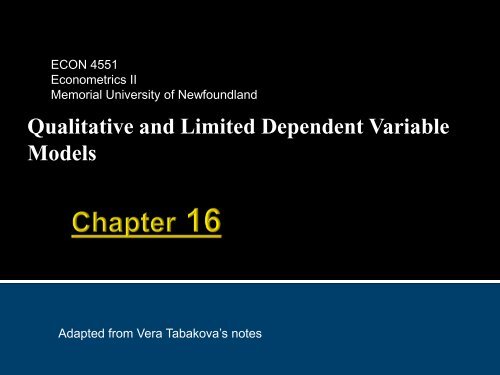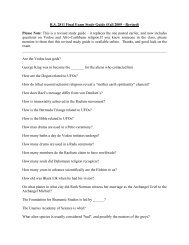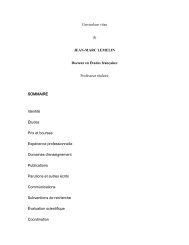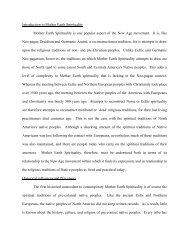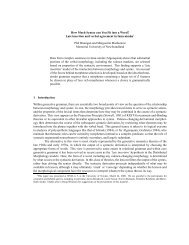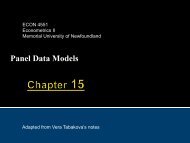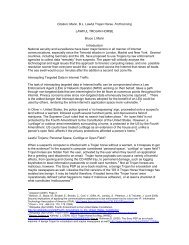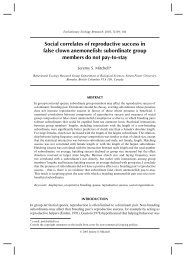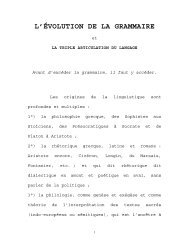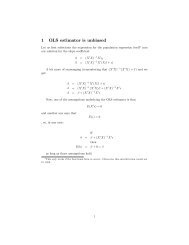Multinomial and Conditional Logit - Memorial University of ...
Multinomial and Conditional Logit - Memorial University of ...
Multinomial and Conditional Logit - Memorial University of ...
You also want an ePaper? Increase the reach of your titles
YUMPU automatically turns print PDFs into web optimized ePapers that Google loves.
ECON 4551<br />
Econometrics II<br />
<strong>Memorial</strong> <strong>University</strong> <strong>of</strong> Newfoundl<strong>and</strong><br />
Qualitative <strong>and</strong> Limited Dependent Variable<br />
Models<br />
Adapted from Vera Tabakova’s notes
• 16.1 Models with Binary Dependent Variables<br />
• 16.2 The <strong>Logit</strong> Model for Binary Choice<br />
• 16.3 <strong>Multinomial</strong> <strong>Logit</strong><br />
• 16.4 <strong>Conditional</strong> <strong>Logit</strong><br />
• 16.5 Ordered Choice Models<br />
• 16.6 Models for Count Data<br />
• 16.7 Limited Dependent Variables<br />
Principles <strong>of</strong> Econometrics, 3rd Edition<br />
Slide 16-2
Examples <strong>of</strong> multinomial choice (polytomous) situations:<br />
1. Choice <strong>of</strong> a laundry detergent: Tide, Cheer, Arm & Hammer, Wisk,<br />
etc.<br />
2. Choice <strong>of</strong> a major: economics, marketing, management, finance or<br />
accounting.<br />
3. Choices after graduating from high school: not going to college,<br />
going to a private 4-year college, a public 4 year-college, or a 2-year<br />
college.<br />
Principles <strong>of</strong> Econometrics, 3rd Edition<br />
Slide16-3
The explanatory variable x i is individual specific, but does not<br />
change across alternatives. Example age <strong>of</strong> the individual.<br />
The dependent variable is nominal<br />
Principles <strong>of</strong> Econometrics, 3rd Edition<br />
Slide16-4
Examples <strong>of</strong> multinomial choice situations:<br />
1. It is key that there are more than 2 choices<br />
2. It is key that there is no meaningful ordering to<br />
them. Otherwise we would want to use that<br />
information (with an ordered probit or ordered<br />
logit)<br />
In GRETL, you must specify MNL, or the program will assume meaningful<br />
ordering!<br />
Principles <strong>of</strong> Econometrics, 3rd Edition<br />
Slide16-5
In essence this model is like a set <strong>of</strong> simultaneous<br />
individual binomial logistic regressions<br />
With appropriate weighting, since the different<br />
comparisons between different pairs <strong>of</strong> categories<br />
would generally involve different numbers <strong>of</strong><br />
observations<br />
Principles <strong>of</strong> Econometrics, 3rd Edition<br />
Slide16-6
p P individual i chooses alternative j<br />
ij<br />
<br />
Why is this “one”<br />
p<br />
i1<br />
<br />
1<br />
1 exp exp <br />
x x <br />
12 22 i<br />
13 23<br />
i<br />
, j1<br />
(16.19a)<br />
p<br />
i2<br />
<br />
exp12 22xi<br />
<br />
x x <br />
1 exp exp <br />
12 22 i<br />
13 23<br />
i<br />
, j2<br />
(16.19b)<br />
p<br />
i3<br />
<br />
exp13 23xi<br />
<br />
x x <br />
1 exp exp <br />
12 22 i<br />
13 23<br />
i<br />
, j3<br />
(16.19c)<br />
Principles <strong>of</strong> Econometrics, 3rd Edition<br />
Slide16-7
P y 1, y 1, y 1<br />
p p p<br />
11 22 33 11 22 33<br />
<br />
We solve using Maximum<br />
Likelihood<br />
1<br />
<br />
1 exp exp <br />
x x <br />
12 22 1 13 23 1<br />
exp12 22x2<br />
<br />
x x <br />
1 exp exp <br />
12 22 2 13 23 2<br />
<br />
<br />
Principles <strong>of</strong> Econometrics, 3rd Edition<br />
<br />
exp13 23x3<br />
<br />
x x <br />
1 exp exp <br />
L , , , <br />
12 22 3 13 23 3<br />
12 22 13 23<br />
<br />
Slide16-8
Again, marginal effects are complicated: there are several types <strong>of</strong> reporting to consider<br />
p<br />
01<br />
1<br />
<br />
12 22x0 13 23x0<br />
1 exp exp<br />
<br />
<br />
(16.20)<br />
p<br />
p<br />
3<br />
im<br />
im<br />
pim 2m 2j pij<br />
xi<br />
x<br />
<br />
<br />
<br />
all else constant i j1<br />
<br />
<br />
<br />
For example reporting the difference in predicted probabilities for two values <strong>of</strong> a variable<br />
p p p<br />
1 b1 a1<br />
1 1<br />
<br />
<br />
1 exp exp 1 exp exp <br />
12 22xb 13 23xb 12 22xa 13 23xa<br />
<br />
Principles <strong>of</strong> Econometrics, 3rd Edition<br />
Slide16-9
P y<br />
i<br />
P y<br />
i<br />
<br />
j<br />
1<br />
<br />
<br />
pij<br />
exp <br />
1j 2jxi<br />
j<br />
2,3<br />
p<br />
i1<br />
(16.21)<br />
<br />
<br />
p<br />
ij<br />
x<br />
i<br />
p<br />
i1<br />
<br />
<br />
exp x j<br />
2,3<br />
2 j 1 j 2 j i<br />
<br />
(16.22)<br />
An interesting feature <strong>of</strong> the odds ratio (16.21) is that the odds <strong>of</strong> choosing<br />
alternative j rather than alternative 1 does not depend on how many alternatives<br />
there are in total. There is the implicit assumption in logit models that the odds<br />
between any pair <strong>of</strong> alternatives is independent <strong>of</strong> irrelevant alternatives (IIA).<br />
Principles <strong>of</strong> Econometrics, 3rd Edition<br />
Slide16-10
IIA assumption<br />
• There is the implicit assumption in logit models that the odds between any pair <strong>of</strong><br />
alternatives is independent <strong>of</strong> irrelevant alternatives (IIA)<br />
One way to state the assumption<br />
• If choice A is preferred to choice B out <strong>of</strong> the choice set {A,B}, then<br />
introducing a third alternative X, thus exp<strong>and</strong>ing that choice set to<br />
{A,B,X}, must not make B preferable to A.<br />
• which kind <strong>of</strong> makes sense <br />
Principles <strong>of</strong> Econometrics, 3rd Edition<br />
Slide16-11
IIA assumption<br />
• There is the implicit assumption in logit models that the odds between any pair <strong>of</strong><br />
alternatives is independent <strong>of</strong> irrelevant alternatives (IIA)<br />
In the case <strong>of</strong> the multinomial logit model, the IIA implies that adding<br />
another alternative or changing the characteristics <strong>of</strong> a third<br />
alternative must not affect the relative odds between the two<br />
alternatives considered.<br />
This is not realistic for many real life applications involving similar<br />
(substitute) alternatives.<br />
Principles <strong>of</strong> Econometrics, 3rd Edition<br />
Slide16-12
IIA assumption<br />
This is not realistic for many real life applications with similar<br />
(substitute) alternatives<br />
Examples:<br />
• Beethoven/Debussy versus another <strong>of</strong> Beethoven’s Symphonies<br />
(Debreu 1960; Tversky 1972)<br />
• Bicycle/Pony (Luce <strong>and</strong> Suppes 1965)<br />
• Red Bus/Blue Bus (McFadden 1974).<br />
• Black slacks, jeans, shorts versus blue slacks (H<strong>of</strong>fman, 2004)<br />
• Etc.<br />
Principles <strong>of</strong> Econometrics, 3rd Edition<br />
Slide16-13
IIA assumption<br />
Red Bus/Blue Bus (McFadden 1974).<br />
• Imagine commuters first face a decision between two modes <strong>of</strong> transportation: car <strong>and</strong> red<br />
bus<br />
• Suppose that a consumer chooses between these two options with equal probability, 0.5, so<br />
that the odds ratio equals 1.<br />
• Now add a third mode, blue bus. Assuming bus commuters do not care about the color <strong>of</strong> the<br />
bus (they are perfect substitutes), consumers are expected to choose between bus <strong>and</strong> car still<br />
with equal probability, so the probability <strong>of</strong> car is still 0.5, while the probabilities <strong>of</strong> each <strong>of</strong><br />
the two bus types should go down to 0.25<br />
• However, this violates IIA: for the odds ratio between car <strong>and</strong> red bus to be preserved, the<br />
new probabilities must be: car 0.33; red bus 0.33; blue bus 0.33<br />
• Te IIA axiom does not mix well with perfect substitutes
IIA assumption<br />
We can test this assumption with a Hausman-McFadden test which<br />
compares a logistic model with all the choices with one with<br />
restricted choices (mlogtest, hausman base in STATA, but check<br />
option detail too: mlogtest, hausman detail)<br />
However, see Cheng <strong>and</strong> Long (2007)<br />
Another test is Small <strong>and</strong> Hsiao’s (1985)<br />
STATA’s comm<strong>and</strong> is mlogtest, smhsiao (careful: the sample is<br />
r<strong>and</strong>omly split every time, so you must set the seed if you want to<br />
replicate your results)<br />
See Long <strong>and</strong> Freese’s book for details <strong>and</strong> worked examples
IIA assumption<br />
use nels_small, clear<br />
. mlogit psechoice grades faminc parcoll, baseoutcome(1) nolog<br />
<strong>Multinomial</strong> logistic regression Number <strong>of</strong> obs = 1000<br />
LR chi2(6) = 342.22<br />
Prob > chi2 = 0.0000<br />
Log likelihood = -847.54576 Pseudo R2 = 0.1680<br />
2<br />
psechoice Coef. Std. Err. z P>|z| [95% Conf. Interval]<br />
1 (base outcome)<br />
average grade on 13 point scale with 1 = highest<br />
grades -.2891448 .0530752 -5.45 0.000 -.3931703 -.1851192<br />
faminc .0080757 .004009 2.01 0.044 .0002182 .0159332<br />
parcoll .5370023 .2892469 1.86 0.063 -.0299112 1.103916<br />
_cons 1.942856 .4561356 4.26 0.000 1.048847 2.836866<br />
3<br />
grades -.6558358 .0540845 -12.13 0.000 -.7618394 -.5498321<br />
faminc .0132383 .0038992 3.40 0.001 .005596 .0208807<br />
parcoll 1.067561 .274181 3.89 0.000 .5301758 1.604946<br />
_cons 4.57382 .4392376 10.41 0.000 3.71293 5.43471<br />
. mlogtest, hausman<br />
**** Hausman tests <strong>of</strong> IIA assumption (N=1000)<br />
Ho: Odds(Outcome-J vs Outcome-K) are independent <strong>of</strong> other alternatives.<br />
Omitted chi2 df P>chi2 evidence<br />
2 0.206 4 0.995 for Ho<br />
3 0.021 4 1.000 for Ho
.<br />
IIA assumption<br />
. mlogit psechoice grades faminc , baseoutcome(1) nolog<br />
<strong>Multinomial</strong> logistic regression Number <strong>of</strong> obs = 1000<br />
LR chi2(4) = 323.70<br />
Prob > chi2 = 0.0000<br />
Log likelihood = -856.80718 Pseudo R2 = 0.1589<br />
psechoice Coef. Std. Err. z P>|z| [95% Conf. Interval]<br />
1 (base outcome)<br />
2<br />
3<br />
grades -.2962217 .0526424 -5.63 0.000 -.3993989 -.1930446<br />
faminc .0108711 .0038504 2.82 0.005 .0033245 .0184177<br />
_cons 1.965071 .4550879 4.32 0.000 1.073115 2.857027<br />
grades -.6794793 .0535091 -12.70 0.000 -.7843553 -.5746034<br />
faminc .0188675 .0037282 5.06 0.000 .0115603 .0261747<br />
_cons 4.724423 .4362826 10.83 0.000 3.869325 5.579521<br />
. mlogtest, smhsiao<br />
**** Small-Hsiao tests <strong>of</strong> IIA assumption (N=1000)<br />
Ho: Odds(Outcome-J vs Outcome-K) are independent <strong>of</strong> other alternatives.<br />
Omitted lnL(full) lnL(omit) chi2 df P>chi2 evidence<br />
2 -171.559 -170.581 1.955 3 0.582 for Ho<br />
3 -156.227 -153.342 5.770 3 0.123 for Ho
IIA assumption<br />
The r<strong>and</strong>omness…due to different splittings <strong>of</strong> the sample<br />
. mlogtest, smhsiao<br />
**** Small-Hsiao tests <strong>of</strong> IIA assumption (N=1000)<br />
Ho: Odds(Outcome-J vs Outcome-K) are independent <strong>of</strong> other alternatives.<br />
Omitted lnL(full) lnL(omit) chi2 df P>chi2 evidence<br />
2 -158.961 -154.880 8.162 3 0.043 against Ho<br />
3 -149.106 -147.165 3.880 3 0.275 for Ho
IIA assumption<br />
• Extensions have arisen to deal with this issue<br />
• The multinomial probit <strong>and</strong> the mixed logit are alternative models for nominal outcomes that<br />
relax IIA, by allowing correlation among the errors (to reflect similarity among options)<br />
• but these models <strong>of</strong>ten have issues <strong>and</strong> assumptions themselves <br />
• IIA can also be relaxed by specifying a hierarchical model, ranking the choice alternatives.<br />
The most popular <strong>of</strong> these is called the McFadden’s nested logit model, which allows<br />
correlation among some errors, but not all (e.g. Heiss 2002)<br />
• Generalized extreme value <strong>and</strong> multinomial probit models possess another property, the<br />
Invariant Proportion <strong>of</strong> Substitution (Steenburgh 2008), which itself also suggests similarly<br />
counterintuitive real-life individual choice behavior<br />
• The multinomial probit has serious computational disadvantages too, since it involves<br />
calculating multiple (one less than the number <strong>of</strong> categories) integrals. With integration by<br />
simulation this problem is being ameliorated now…
. tab psechoice<br />
no college<br />
= 1, 2 =<br />
2-year<br />
college, 3<br />
= 4-year<br />
college Freq. Percent Cum.<br />
1 222 22.20 22.20<br />
2 251 25.10 47.30<br />
3 527 52.70 100.00<br />
Total 1,000 100.00<br />
Principles <strong>of</strong> Econometrics, 3rd Edition<br />
Slide16-20
mlogit psechoice grades, baseoutcome(1)<br />
. mlogit psechoice grades, baseoutcome(1)<br />
Iteration 0: log likelihood = -1018.6575<br />
Iteration 1: log likelihood = -881.68524<br />
Iteration 2: log likelihood = -875.36084<br />
Iteration 3: log likelihood = -875.31309<br />
Iteration 4: log likelihood = -875.31309<br />
<strong>Multinomial</strong> logistic regression Number <strong>of</strong> obs = 1000<br />
LR chi2(2) = 286.69<br />
Prob > chi2 = 0.0000<br />
Log likelihood = -875.31309 Pseudo R2 = 0.1407<br />
psechoice Coef. Std. Err. z P>|z| [95% Conf. Interval]<br />
1 (base outcome)<br />
2<br />
3<br />
grades -.3087889 .0522849 -5.91 0.000 -.4112654 -.2063125<br />
_cons 2.506421 .4183848 5.99 0.000 1.686402 3.32644<br />
grades -.7061967 .0529246 -13.34 0.000 -.809927 -.6024664<br />
_cons 5.769876 .4043229 14.27 0.000 4.977417 6.562334
. tab psechoice, gen(coll)<br />
So we can run the individual logits by h<strong>and</strong>…here “3-year college” versus “no college”<br />
. logit coll2 grades if psechoice chi2 = 0.0000<br />
Log likelihood = -308.37104 Pseudo R2 = 0.0569<br />
coll2 Coef. Std. Err. z P>|z| [95% Conf. Interval]<br />
grades -.3059161 .053113 -5.76 0.000 -.4100156 -.2018165<br />
_cons 2.483675 .4241442 5.86 0.000 1.652367 3.314982
. tab psechoice, gen(coll)<br />
So we can run the individual logits by h<strong>and</strong>…here “4 year college” versus “no college”<br />
. logit coll3 grades if psechoice!=2 Coefficients should look<br />
familiar…<br />
But check sample sizes!<br />
Iteration 0: log likelihood = -455.22643<br />
Iteration 1: log likelihood = -337.82899<br />
Iteration 2: log likelihood = -328.85866<br />
Iteration 3: log likelihood = -328.76478<br />
Iteration 4: log likelihood = -328.76471<br />
Iteration 5: log likelihood = -328.76471<br />
Logistic regression Number <strong>of</strong> obs = 749<br />
LR chi2(1) = 252.92<br />
Prob > chi2 = 0.0000<br />
Log likelihood = -328.76471 Pseudo R2 = 0.2778<br />
coll3 Coef. Std. Err. z P>|z| [95% Conf. Interval]<br />
grades -.7151864 .0576598 -12.40 0.000 -.8281976 -.6021752<br />
_cons 5.832757 .436065 13.38 0.000 4.978085 6.687428
Principles <strong>of</strong> Econometrics, 3rd Edition<br />
Slide16-24
Principles <strong>of</strong> Econometrics, 3rd Edition<br />
Slide16-25
* compute predictions <strong>and</strong> summarize<br />
predict ProbNo ProbCC ProbColl<br />
summarize ProbNo ProbCC ProbColl<br />
. predict ProbNo ProbCC ProbColl<br />
(option pr assumed; predicted probabilities)<br />
. summarize ProbNo ProbCC ProbColl<br />
This must always<br />
Happen, so do not<br />
Use sample values<br />
To assess predictive accuracy!<br />
Variable Obs Mean Std. Dev. Min Max<br />
ProbNo 1000 .222 0 .222 .222<br />
ProbCC 1000 .251 0 .251 .251<br />
ProbColl 1000 .527 0 .527 .527<br />
Principles <strong>of</strong> Econometrics, 3rd Edition<br />
Slide16-26
Compute marginal effects, say for outcome 1 (no college)<br />
. mfx, predict(outcome(1))<br />
Marginal effects after mlogit<br />
y = Pr(psechoice==1) (predict, outcome(1))<br />
= .17193474<br />
If not specified, calculation is done at<br />
means<br />
variable dy/dx Std. Err. z P>|z| [ 95% C.I. ] X<br />
grades .0813688 .00595 13.68 0.000 .069707 .09303 6.53039<br />
. sum grades<br />
Variable Obs Mean Std. Dev. Min Max<br />
grades 1000 6.53039 2.265855 1.74 12.33<br />
Principles <strong>of</strong> Econometrics, 3rd Edition<br />
Slide16-27
Compute marginal effects, say for outcome 1 (no college)<br />
. mfx, predict(outcome(1)) at ( grades=5)<br />
Marginal effects after mlogit<br />
y = Pr(psechoice==1) (predict, outcome(1))<br />
= .07691655<br />
If specified, calculation is done at<br />
chosen level<br />
variable dy/dx Std. Err. z P>|z| [ 95% C.I. ] X<br />
grades .0439846 .00357 12.31 0.000 .036984 .050985 5
Another annotated example<br />
• http://www.ats.ucla.edu/stat/Stata/output/stata_mlogit_output.htm<br />
• This example showcases also the use <strong>of</strong> the option rrr which yields the<br />
interpretation <strong>of</strong> the multinomial logistic regression in terms <strong>of</strong> relative<br />
risk ratios<br />
• In general, the relative risk is a ratio <strong>of</strong> the probability <strong>of</strong> an event in the exposed<br />
group versus a non-exposed group. Used <strong>of</strong>ten in epidemiology
In STATA<br />
• mlogit<br />
• Note that you should specify the base category<br />
or STATA will choose the most frequent one<br />
• It is interesting to experiment with changing<br />
the base category<br />
• Or use listcoef to get more results<br />
automatically
In STATA<br />
Careful with perfect prediction, which in this model will not be<br />
flagged!!!<br />
You can see that the Z values are zero for some variables <strong>and</strong><br />
the p-values will be 1, but STATA will not send a warning<br />
message now!<br />
Similar for ologit <strong>and</strong> oprobit later…
Consider testing whether two categories could<br />
be combined<br />
If none <strong>of</strong> the independent variables really<br />
explain the odds <strong>of</strong> choosing choice A versus<br />
B, you should merge them<br />
In STATA<br />
mlogtest, combine (Wald test)<br />
Or<br />
mlogtest, lrcomb (LR test)
mlogit psechoice grades faminc , baseoutcome(3)<br />
. mlogtest, combine<br />
**** Wald tests for combining alternatives (N=1000)<br />
Ho: All coefficients except intercepts associated with a given pair<br />
<strong>of</strong> alternatives are 0 (i.e., alternatives can be combined).<br />
mlogit psechoice grades faminc , baseoutcome(3)<br />
Alternatives tested chi2 df P>chi2<br />
1- 2 41.225 2 0.000<br />
1- 3 187.029 2 0.000<br />
2- 3 97.658 2 0.000<br />
Where does this<br />
come from?
mlogit psechoice grades faminc , baseoutcome(3)<br />
. test[1]<br />
( 1) [1]grades = 0<br />
( 2) [1]faminc = 0<br />
We test whether all the<br />
Coefficients are null<br />
When comparing<br />
category 1 to the base,<br />
Which is 3 here<br />
chi2( 2) = 187.03<br />
Prob > chi2 = 0.0000
mlogit psechoice grades faminc , baseoutcome(3)<br />
. mlogtest, lrcomb<br />
**** LR tests for combining alternatives (N=1000)<br />
Ho: All coefficients except intercepts associated with a given pair<br />
<strong>of</strong> alternatives are 0 (i.e., alternatives can be collapsed).<br />
Alternatives tested chi2 df P>chi2<br />
1- 2 46.360 2 0.000<br />
1- 3 294.004 2 0.000<br />
2- 3 118.271 2 0.000<br />
These tests are based on comparing unrestricted versus constrained<br />
Regressions, where only the intercept is nonzero for the relevant category
These tests are based on comparing unrestricted versus constrained<br />
Regressions, where only the intercept is nonzero for the relevant category:<br />
mlogit psechoice grades faminc , baseoutcome(3) nolog<br />
est store unrestricted<br />
constraint define 27 [1]<br />
mlogit psechoice grades faminc , baseoutcome(3) constraint(27) nolog<br />
est store restricted<br />
lrtest restricted unrestricted<br />
Yields:<br />
Likelihood-ratio test LR chi2(2) = 294.00<br />
(Assumption: restricted nested in unrestricted) Prob > chi2 = 0.0000
Computational issues make the <strong>Multinomial</strong> Probit<br />
very rare<br />
LIMDEP seemed to be one <strong>of</strong> the few s<strong>of</strong>tware<br />
packages that used to include a canned routine for it<br />
STATA has now asmprobit<br />
Advantage: it does not need IIA
. tab hscath<br />
= 1 if<br />
catholic<br />
high school<br />
graduate Freq. Percent Cum.<br />
0 981 98.10 98.10<br />
1 19 1.90 100.00<br />
Total 1,000 100.00
. mlogit hscath grades, baseoutcome(1) nolog<br />
<strong>Multinomial</strong> logistic regression Number <strong>of</strong> obs = 1000<br />
LR chi2(1) = 0.21<br />
Prob > chi2 = 0.6445<br />
Log likelihood = -94.014874 Pseudo R2 = 0.0011<br />
hscath Coef. Std. Err. z P>|z| [95% Conf. Interval]<br />
0<br />
grades .0471052 .1020326 0.46 0.644 -.1528749 .2470853<br />
_cons 3.642004 .6830122 5.33 0.000 2.303325 4.980684<br />
1 (base outcome)<br />
. logit hscath grades, nolog<br />
Why are the coefficient signs reversed?<br />
Logistic regression Number <strong>of</strong> obs = 1000<br />
LR chi2(1) = 0.21<br />
Prob > chi2 = 0.6445<br />
Log likelihood = -94.014874 Pseudo R2 = 0.0011<br />
hscath Coef. Std. Err. z P>|z| [95% Conf. Interval]<br />
grades -.0471052 .1020326 -0.46 0.644 -.2470853 .1528749<br />
_cons -3.642004 .6830122 -5.33 0.000 -4.980684 -2.303325
Example: choice between three types (J = 3) <strong>of</strong> s<strong>of</strong>t drinks, say Pepsi,<br />
7-Up <strong>and</strong> Coke Classic.<br />
Let y i1 , y i2 <strong>and</strong> y i3 be dummy variables that indicate the choice made<br />
by individual i. The price facing individual i for br<strong>and</strong> j is PRICE ij .<br />
Variables like price are to be individual <strong>and</strong> alternative specific,<br />
because they vary from individual to individual <strong>and</strong> are different for<br />
each choice the consumer might make<br />
Principles <strong>of</strong> Econometrics, 3rd Edition<br />
Slide16-40
Variables like price are to be individual <strong>and</strong> alternative specific,<br />
because they vary from individual to individual <strong>and</strong> are different for<br />
each choice the consumer might make<br />
Another example: <strong>of</strong> mode <strong>of</strong> transportation choice: time from home<br />
to work using train, car, or bus.<br />
• GRETL doesn't include a routine to estimate conditional<br />
logit yet (as <strong>of</strong> version 1.8.1), so you'll want to use R to<br />
estimate this model<br />
Principles <strong>of</strong> Econometrics, 3rd Edition<br />
Slide16-41
p P individual i chooses alternative j<br />
ij<br />
<br />
p<br />
ij<br />
<br />
exp<br />
<br />
1j<br />
2<br />
PRICE PRICE PRICE <br />
exp exp exp<br />
<br />
<br />
PRICE<br />
11 2 i1 12 2 i2 13 2 i3<br />
ij<br />
<br />
(16.23)<br />
Principles <strong>of</strong> Econometrics, 3rd Edition<br />
Slide16-42
P y 1, y 1, y 1<br />
p p p<br />
<br />
11 22 33 11 22 33<br />
<br />
exp11 2PRICE11<br />
PRICE PRICE <br />
PRICE <br />
exp exp exp<br />
exp12 2PRICE22<br />
<br />
PRICE PRICE <br />
PRICE <br />
<br />
11 2 11 12 2 12 2 13<br />
exp exp exp<br />
exp<br />
<br />
11 2 21 12 2 22 2 23<br />
<br />
exp<br />
PRICE exp <br />
11 2 31 12 2<br />
L , , <br />
12 22 2<br />
<br />
common<br />
2PRICE33<br />
<br />
PRICE exp<br />
PRICE <br />
We normalise one intercept to zero<br />
32 2 33<br />
<br />
<br />
Principles <strong>of</strong> Econometrics, 3rd Edition<br />
Slide16-43
• The own price effect is:<br />
p<br />
ij<br />
PRICE<br />
ij<br />
ij<br />
1<br />
p ij 2<br />
p <br />
(16.24)<br />
• The cross price effect is:<br />
p<br />
ij<br />
PRICE<br />
ik<br />
pp<br />
ij<br />
ik<br />
<br />
2<br />
(16.25)<br />
Principles <strong>of</strong> Econometrics, 3rd Edition<br />
Slide16-44
p<br />
p<br />
ij<br />
<br />
<br />
ik 1k 2 ik<br />
<br />
exp 1j<br />
2PRICEij<br />
exp <br />
exp PRICE <br />
<br />
1 j 1k 2 PRICEij PRICEik<br />
<br />
<br />
<br />
The odds ratio depends on the difference in prices, but not on the prices<br />
themselves. As in the multinomial logit model this ratio does not depend on<br />
the total number <strong>of</strong> alternatives, <strong>and</strong> there is the implicit assumption <strong>of</strong> the<br />
independence <strong>of</strong> irrelevant alternatives (IIA).<br />
Principles <strong>of</strong> Econometrics, 3rd Edition<br />
Slide16-45
Principles <strong>of</strong> Econometrics, 3rd Edition<br />
Slide16-46
The predicted probability <strong>of</strong> a Pepsi purchase, given that the price <strong>of</strong><br />
Pepsi is $1, the price <strong>of</strong> 7-Up is $1.25 <strong>and</strong> the price <strong>of</strong> Coke is $1.10<br />
is:<br />
p i 1<br />
exp <br />
11<br />
2<br />
1.00<br />
<br />
11<br />
2 12 2 2<br />
<br />
ˆ <br />
.4832<br />
exp 1.00 exp 1.25 exp 1.10
use http://www.stata-press.com/data/lf2/travel2.dta, clear<br />
. use http://www.stata-press.com/data/lf2/travel2.dta<br />
(Greene & Hensher 1997 data on travel mode choice)<br />
. list id mode train bus time invc choice in 1/6, sepby(id)<br />
id mode train bus time invc choice<br />
1. 1 Train 1 0 406 31 0<br />
2. 1 Bus 0 1 452 25 0<br />
3. 1 Car 0 0 180 10 1<br />
4. 2 Train 1 0 398 31 0<br />
5. 2 Bus 0 1 452 25 0<br />
6. 2 Car 0 0 255 11 1<br />
Principles <strong>of</strong> Econometrics, 3rd Edition<br />
Slide16-48
• For this transportation example, the dependent variable is<br />
choice, a binary variable indicating which mode <strong>of</strong><br />
transportation was chosen<br />
• The regressors include the J − 1 dummy variables train <strong>and</strong><br />
bus that identify each alternative mode <strong>of</strong> transportation <strong>and</strong><br />
the alternative-specific variables time <strong>and</strong> invc (invc contains<br />
the in-vehicle cost <strong>of</strong> the trip: we expect that the higher the<br />
cost <strong>of</strong> traveling by some mode, the less likely a person is to<br />
choose that mode)<br />
• Use the option group(id) to specify that the id variable<br />
identifies the groups in the sample
Example from Greene <strong>and</strong> Hensher (1997) used by<br />
Long <strong>and</strong> Freese too illustrate clogit in STATA:<br />
• Data on 152 groups (id) <strong>of</strong> travelers, choosing<br />
between three modes <strong>of</strong> travel: train, bus or car<br />
• For each group, there are three rows <strong>of</strong> data<br />
corresponding to the three choices faced by each<br />
group, so we have N × J = 152 × 3 = 456<br />
observations.
• Two dummy variables (a third would be redundant)<br />
are used to indicate the mode <strong>of</strong> travel corresponding<br />
to a given row <strong>of</strong> data<br />
• train is 1 if the observation has information about<br />
taking the train, else train is 0.<br />
• bus is 1 if the observation contains information about<br />
taking a bus, else 0. If both train <strong>and</strong> bus are 0, the<br />
observation has information about driving a car.<br />
• The actual choice made is shown by the dummy<br />
variable choice equal to 1 if the person took the<br />
mode <strong>of</strong> travel corresponding to a specific<br />
observation
Estimates for time <strong>and</strong> invc are negative: the longer it takes to travel<br />
by a given mode, the less likely that mode is to be chosen. Similarly,<br />
the more it costs, the less likely a mode is to be chosen<br />
. clogit choice train bus time invc, group(id) nolog<br />
<strong>Conditional</strong> (fixed-effects) logistic regression Number <strong>of</strong> obs = 456<br />
LR chi2(4) = 172.06<br />
Prob > chi2 = 0.0000<br />
Log likelihood = -80.961135 Pseudo R2 = 0.5152<br />
choice Coef. Std. Err. z P>|z| [95% Conf. Interval]<br />
train 2.671238 .4531611 5.89 0.000 1.783058 3.559417<br />
bus 1.472335 .4007152 3.67 0.000 .6869474 2.257722<br />
time -.0191453 .0024509 -7.81 0.000 -.0239489 -.0143417<br />
invc -.0481658 .0119516 -4.03 0.000 -.0715905 -.0247411
. listcoef<br />
clogit (N=456): Factor Change in Odds<br />
Odds <strong>of</strong>: 1 vs 0<br />
Odds-ratios<br />
choice b z P>|z| e^b<br />
train 2.67124 5.895 0.000 14.4579<br />
bus 1.47233 3.674 0.000 4.3594<br />
time -0.01915 -7.812 0.000 0.9810<br />
invc -0.04817 -4.030 0.000 0.9530<br />
Everything else the same in time <strong>and</strong> invc,<br />
people prefer the bus <strong>and</strong> much prefer the<br />
train over the car
• For the alternative-specific variables, time <strong>and</strong> invc,<br />
the odds ratios are the multiplicative effect <strong>of</strong> a unit<br />
change in a given independent variable on the odds<br />
<strong>of</strong> any given mode <strong>of</strong> travel<br />
• E.g.: Increasing travel time by one minute for a<br />
given mode <strong>of</strong> transportation decreases the odds <strong>of</strong><br />
using that mode <strong>of</strong> travel by a factor <strong>of</strong> .98 (2%),<br />
holding the values for the other alternatives<br />
constant<br />
• If time for car increases in one minute while the<br />
time for train <strong>and</strong> bus remain the same, the odds <strong>of</strong><br />
traveling by car decrease by 2 percent
• The odds ratios for the alternative-specific<br />
constants bus <strong>and</strong> train indicate the relative<br />
likelihood <strong>of</strong> choosing these options versus<br />
travelling by car (the base category), assuming that<br />
cost <strong>and</strong> time are the same for all options<br />
• E.g.: If cost <strong>and</strong> time were equal, individuals would<br />
be 4.36 times more likely to travel by bus than by<br />
car, <strong>and</strong> they would be 14.46 times more likely to<br />
travel by train than by car
• Note that the data structure for the analysis<br />
<strong>of</strong> the conditional logit is rather special<br />
• Long <strong>and</strong> Freese <strong>of</strong>fer good advice on how to<br />
set up data that are structured in a more<br />
conventional fashion
• Note that any multinomial logit model can be<br />
estimated using clogit by exp<strong>and</strong>ing the dataset<br />
(see Long <strong>and</strong> Freese for details) <strong>and</strong> respecifying<br />
the independent variables as a set <strong>of</strong> interactions<br />
• This opens up the possibility <strong>of</strong> mixed models that<br />
include both individual-specific <strong>and</strong> alternativespecific<br />
variables (are richer travelers more likely to<br />
drive than to take the bus?)<br />
• This opens up the possibility <strong>of</strong> imposing constraints<br />
on parameters in clogit that are not possible with<br />
mlogit (see Hendrickx 2001)
• binary choice models<br />
• censored data<br />
• conditional logit<br />
• count data models<br />
• feasible generalized least squares<br />
• Heckit<br />
• identification problem<br />
• independence <strong>of</strong> irrelevant<br />
alternatives (IIA)<br />
• index models<br />
• individual <strong>and</strong> alternative specific<br />
variables<br />
• individual specific variables<br />
• latent variables<br />
• likelihood function<br />
• limited dependent variables<br />
• linear probability model<br />
Principles <strong>of</strong> Econometrics, 3rd Edition<br />
• logistic r<strong>and</strong>om variable<br />
• logit<br />
• log-likelihood function<br />
• marginal effect<br />
• maximum likelihood estimation<br />
• multinomial choice models<br />
• multinomial logit<br />
• odds ratio<br />
• ordered choice models<br />
• ordered probit<br />
• ordinal variables<br />
• Poisson r<strong>and</strong>om variable<br />
• Poisson regression model<br />
• probit<br />
• selection bias<br />
• tobit model<br />
• truncated data<br />
Slide 16-58
• Long, S. <strong>and</strong> J. Freese for all topics (available<br />
on Google!)<br />
• Cameron <strong>and</strong> Trivedi’s book for count data
• Ordered Choice<br />
• Count data


